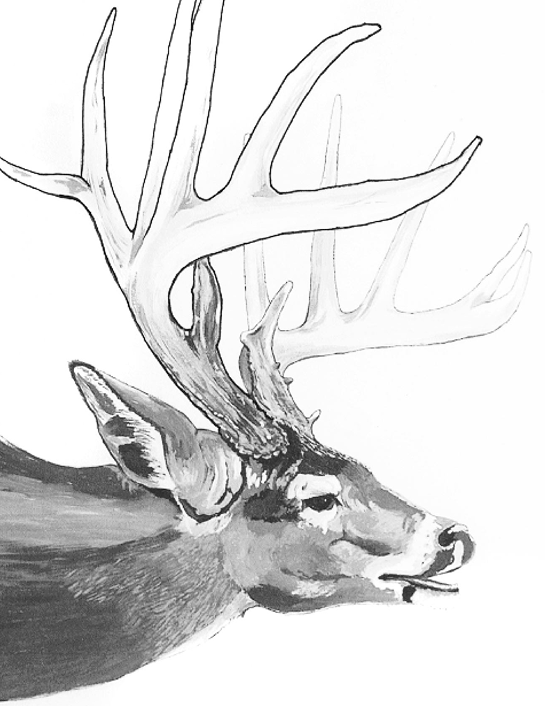BUCKMASTER'S FULL-CREDIT SCORING SYSTEM
The philosophy of Buckmasters’ Full-Credit Scoring System is to measure and record white-tailed deer antlers without forcing them to conform to a criterion of perfect symmetry.

This Full-Credit Scoring System takes nothing away from the rack.
It simply measures every inch of antler and classifies it accordingly.
And, because simple mathematics determines in which category a rack belongs, we’ve removed the incentive for a measurer or hunter to make the call based on how a deer might rank.
To borrow a cliché, “It is what it is.”
Buckmasters’ system is based on the method of evaluating white-tailed deer antlers developed by Russell Thornberry, who recognized that other scoring systems’ symmetry-based formulas often were like shaving square pegs to fit into round holes. Thornberry’s system first appeared in print in “Trophy Deer of Alberta,” published in 1982. Adopted by Buckmasters in the mid-1990s, the Full-Credit Scoring System abandons the punitive pursuit of symmetry and simply gives a rack credit for the full amount of antler present.
As part of a key update in 2025, Buckmasters now includes inside spread as part of the official score. In short, there is one Buckmasters score which consists of the total inches of antler grown, plus the inside spread.

WHY BUCKMASTERS?
Why it was necessary to create a new whitetail scoring system:
There are several other whitetail scoring systems with big names, but they didn't get it right.
Other scoring systems are based on one very big and very flawed premise: That whitetail antlers should match from one side to the other. Those systems actually deduct from the score any differences in tine length and circumferences between the left and right beams. This philosophy is so bonkers that many hunters have taken up the saying, "Nets are for fishing." We agree. Buckmasters does not deduct differences between lengths of typical points and circumferences, nor do we have gross and net scores. Finally, we don't penalize a mostly typical rack for irregular growth.
THE SYSTEM
Buckmasters Full Credit Scoring System
Buckmasters can be distinguished from other whitetail scoring systems in seven important areas:
Buckmasters does not deduct differences between lengths of opposing typical points or circumferences. Nor do we penalize a mostly typical rack for irregular growth. When measuring typical tines, no deduction is made when one typical point does not have a matching point on the opposite antler. An example would be a 9-point rack with five typical points on one side and only four typical points on the other. Buckmasters does not force this rack to become a hypothetical 8-pointer by deducting the unmatched point.
To accommodate all possible configurations of antler, Buckmaster has four classifications: Perfect, Regular, Semi-Irregular and Irregular — all determined by simple math.
Minimum scores are based on the weapon used to harvest the deer. The minimum for all firearms-harvested deer, as well as for those found dead, is 155 inches. A minimum score of 120 inches is required for all deer felled by bow. Shed antlers must tally at least 75 inches.
Buckmasters provides separate categories for all types of firearms, including centerfire rifles, shotguns, pistols and blackpowder guns. For deer felled by arrows, there are individual categories for compounds, recurves, longbows and crossbows. The pick-up category is for racks that have been found rather than harvested by a hunter (minimum score is 155). There is also a category for shed antlers, which are measured as a right or left antler, not as a pair. Minimum score for sheds is 75 inches.
No drying time is required before antlers can be measured.
Buckmasters has a separate category for antlers still in velvet. Thus, we do not require that a rack be stripped before it is officially measured. We will score a velvet rack that has taxidermist-applied artificial velvet, provided there is photographic evidence the buck was in velvet when it was taken.
There is opportunity for entry for bucks taken behind game-proof fences of no less than 500 contiguous acres, unobstructed by cross-fencing or any other barrier, providing the deer (1) is not forced to obtain food or water, (2) has sufficient cover in which to seek sanctuary, (3) was born on the tract and not raised by hand, and (4) is otherwise hunted according to the game laws of the state or province. Bucks taken in a high-fence property are not ranked with bucks taken under fully free-range conditions.

HOW TO BECOME A SCORER
All Official Buckmasters Scorers Must Be:
Willing to be accessible to the public on a volunteer basis
Notify the BTR chairman of all changes in physical and email addresses or telephone numbers. Failure to do so, even if a Buckmasters customer service representative has been notified, could result in a measurer's being deleted from the active list. The BTR chairman is the only person with access to the BTR database, which is not connected to the subscription database.
An honorable hunter in good standing
in his community
All official scorer applicants will be required to have a character affidavit signed by their local DNR or Fish and Wildlife Division officer, confirming the applicant has no convictions for hunting-related violations or felonies. If convicted of such after certification, a measurer faces permanent suspension.
To qualify for certification as an official BTR scorer, a candidate must have a general understanding of scoring procedures for white-tailed deer. The candidate must attend an official BTR scorer certification clinic and must demonstrate to the satisfaction of the instructor that he/she comprehends all BTR scoring procedures. In addition, he/she must pass the BTR scorer's test given at the conclusion of the class. If a person doesn't pass the test, no refunds will be issued. The person, however, may attend another class at no charge.

REAL HUNTERS. REAL STORIES. REAL GEAR.